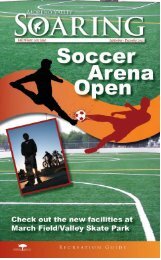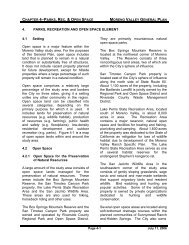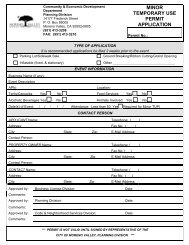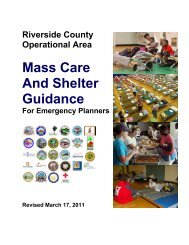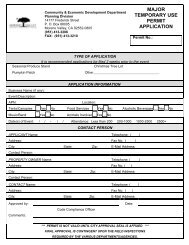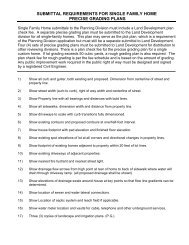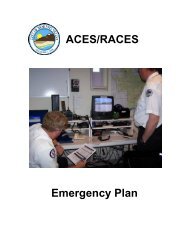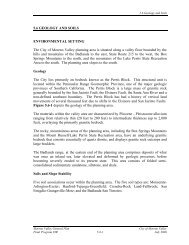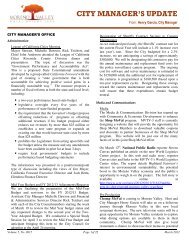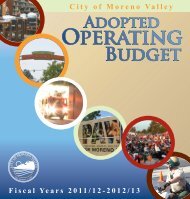General Plan - Moreno Valley
General Plan - Moreno Valley
General Plan - Moreno Valley
You also want an ePaper? Increase the reach of your titles
YUMPU automatically turns print PDFs into web optimized ePapers that Google loves.
CHAPTER 6 – SAFETYlimitations for domestic use.Nitrate concentrations have also been aproblem. As recently as the 1990’s,groundwater pumped by local watercompanies contained nitrate levels thatexceeded state drinking water standards.Water companies had to blend groundwaterwith imported water purchased from theEastern Municipal Water District.Groundwater concentrations of fluoride andboron are relatively high near the SanJacinto Fault Zone. The occurrence of highfluoride and boron concentrations is oftenassociated with geologic faults.In the 1980’s, a plume of contaminatedgroundwater was identified within andimmediately east of March Air ReserveBase. Improper handling of waste fuel, oiland spent solvents was the cause of thecontamination. The predominant pollutantsare tetrachloroethylene andtrichloroethylene. The Air Force operatedwells and facilities to clean and monitor theplume of contaminated groundwater.b. Surface Water QualityThe majority of the surface runoff from thestudy area drains into the San Jacinto River;some of which initially flows southeast intothe San Jacinto <strong>Valley</strong> and some southwestinto the Perris <strong>Valley</strong> Storm Drain. Theremainder of the study area drains to thewest and north into various tributaries of theSanta Ana River, including SycamoreCanyon, Reche Canyon and San TimoteoCanyon.The San Jacinto River drains to thesouthwest into Canyon Lake and LakeElsinore and then northwest into TemescalWash and the Santa Ana River. CanyonLake occasionally discharges into LakeElsinore. Lake Elsinore occasionallydischarges into Temescal Wash, a tributaryof the Santa Ana River. Discharges fromthe lakes are so rare that they areMORENO VALLEY GENERAL PLANessentially closed systems. As such, theyare particularly susceptible to water qualityproblems.Lake Elsinore and Canyon Lake did notmeet state water quality standards adoptedpursuant to the Federal Water PollutionControl Act (Clean Water Act). LakeElsinore experienced algae growth, oxygendepletion and fish kills due to sediment,nitrogen and phosphorus compounds andtoxicity.The Santa Ana Regional Water QualityControl Board adopted a nutrient TotalMaximum Daily Load (TMDL) for CanyonLake and Lake Elsinore. The TMDL whenimplemented will reduce nutrients in thesurface waters tributary to the lakes tolevels that will protect their designated uses.Storm water runoff from the study areacould further degrade downstream waterquality. Some of the pollutants of concerninclude, but are not limited to, sediment, oil,petroleum products, debris and litter, humanand animal waste, fertilizers, pesticides,antifreeze, tire and brake particles,detergents and toxic substances.The pollutants found in urban storm runofforiginate from diverse sources. Sedimentsoriginate from soil erosion. Automobile useis responsible for the deposition ofcontaminants such as asbestos from brakelinings, tire particles, antifreeze, oil andgrease that accumulate on streets andparking surfaces. Fertilizer, organic matterand deposits of air pollutants are sources ofnitrogen and phosphorous in runoff.6.7.2. Issues and Opportunitiesa. Groundwater Quality.There are many programs in place topreserve the quality of groundwater.Examples include the following:• Well Drilling and AbandonmentPage 6-22 July 11, 2006



